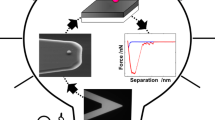Abstract
Bacterial adhesion to biomaterials, mineral surfaces, or other industrial surfaces is strongly controlled by the way bacteria interact with protein layers or organic matter and other biomolecules that coat the materials. Despite this knowledge, many studies of bacterial adhesion are performed under clean conditions, instead of in the presence of proteins or organic molecules. We chose fetal bovine serum (FBS) as a model protein, and prepared FBS films on quartz crystals. The thickness of the FBS layer was characterized using atomic force microscopy (AFM) imaging under liquid and quartz crystal microbalance with dissipation (QCM-D). Next, we characterized how the model biomaterial surface would interact with the nocosomial pathogen Staphylococcus epidermidis. An AFM probe was coated with S. epidermidis cells and used to probe a gold slide that had been coated with FBS or another protein, fibronectin (FN). These experiments show that AFM and QCM-D can be used in complementary ways to study the complex interactions between bacteria, proteins, and surfaces.
Similar content being viewed by others
References
P. Francois et al., J. Lab. Clin. Med., 135 (2000), p. 32.
Y.A. Que et al., J. Exp. Med., 201 (2005), p. 1627.
M. Delmi et al., J. Orthop. Res., 12 (1994), p. 432.
L. Cristancho et al., Vet. Microbiol., 126 (2008), pp. 200–209.
X. Xiao and L. Qian, Langmuir, 16 (2000), pp. 8153–8158.
N.J.C. Strachan et al., Int. J. Food Microbiol., 112 (2006), p. 129.
R.E. Polonio et al., Antimicrob Agents Chemother, 45 (2001), p. 3262.
H.G. Hansma and J.H. Hoh, Annu. Rev. Biophys. Biomol. Struct., 23 (1994), pp. 115–140.
A.P. Gunning et al., J. Colloid and Interface Science, 183 (1996), pp. 600–602.
H.G. Hansma, K. Kasuya, and E. Oroudjev, Curr. Opin. Struct. Biol., 14 (2004), pp. 380–385.
E. Balnois et al., Environmental Science & Technology, 33 (1999), pp. 3911–3917.
K.D. Kwon et al., Environmental Science & Technology, 40 (2006), pp. 7739–7744.
F. Hook et al., Anal. Chem., 73 (2001), pp. 5796–5804.
F. Hook et al., Proceedings of the Joint European Frequency and Time Forum (Neuchatel, Switzerland: Swiss Foundation for Research in Microtechnology, 1999), pp. 966–972.
F. Höök and M. Rudh, Bti, February/March (2005), pp. 8–13.
R. Richter, A. Mukhopadhyay, and A. Brisson, Biophys. J., 85 (2003), pp. 3035–3047.
M.A. Cooper and V.T. Singleton, J. Mol. Recognit., 20 (2007), pp. 154–184.
G. Sauerbrey, Z. Phys. (1959), pp. 206–222.
M.V. Voinova, M. Jonson, and B. Kasemo, Biosens. Bioelectron., 17 (2002), p. 835.
K.K. Kanazawa and J.G. Gordon, Anal. Chim. Acta, 175 (1985), pp. 99–105.
T. Kuzniatsova et al., Microporous and Mesoporous Materials, 103 (2007), pp. 102–107.
J. Malmstrom et al., Langmuir, 23 (2007), pp. 9760–9768.
M.V. Voinova et al., Phys. Scr., 59 (1999), pp. 391–396.
K. Rechendorff et al., J. Appl. Phys. (2007), p. 101.
Y. Liu, J. Strauss, and T.A. Camesano, Langmuir, 23 (2007), pp. 7134–7142.
J. Strauss et al., Microbial Surfaces: Structure, Interactions, and Reactivity, ACS Symposium Series 984, ed. T.A. Camesano and C.M. Mello (Washington, D.C.: American Chemical Society, 2008), pp. 79–99.
Y.S. Liu, J. Camesano, and T.A. Camesano, Biomaterials, 29 (2008), pp. 4374–4382.
Author information
Authors and Affiliations
Corresponding author
Rights and permissions
About this article
Cite this article
Strauss, J., Liu, Y. & Camesano, T.A. Bacterial adhesion to protein-coated surfaces: An AFM and QCM-D study. JOM 61, 71–74 (2009). https://doi.org/10.1007/s11837-009-0138-z
Published:
Issue Date:
DOI: https://doi.org/10.1007/s11837-009-0138-z




